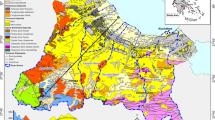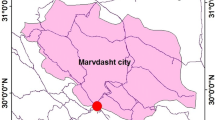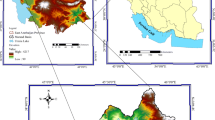Abstract
The water table is an important piece of data for hydrogeological studies, particularly as input data to groundwater simulation models. Since the accuracy of groundwater simulation models significantly depends on input data, this study highlights the application of fuzzy kriging to improve the accuracy of water table interpolation. The results of the fuzzy kriging approach are compared with common methods in water table interpolation like ordinary kriging, inverse distance weighting (IDW), and Thiessen polygon methods to justify the suitability of the fuzzy kriging. The Gilan and Zanjan plains, located in the northwest of Iran, are used as case study areas. The Gilan Plain is characterized by a dense and regular piezometric network and gentle hydraulic gradient. The longitudinal plain of Zanjan has a sparse and irregular piezometric network and steep hydraulic gradient. Since these plains have different piezometric network configurations, the sensitivity of the interpolation methods to the monitoring point configuration is analyzed. The cross-validation method is employed to validate the accuracy of interpolation methods in water table interpolation. In control points, the average of root-mean-square errors associated with groundwater water table values estimated using fuzzy kriging, ordinary kriging, IDW, and Thiessen polygon methods are obtained to be respectively 1.36, 1.93, 3.49, and 9.10 in the Gilan Plain and 13.60, 22.86, 32.30, and 59.81 in the Zanjan Plain. The results indicate that the fuzzy kriging technique has greater precision in comparison with other methods, especially under the conditions of the sparse piezometric network and steep hydraulic gradient. The results also demonstrate that the used methods generally have higher accuracy in the Gilan Plain with a regular piezometric network than in the Zanjan Plain. Furthermore, Thiessen polygon, IDW, and ordinary kriging methods overestimated water table in comparison with the fuzzy kriging method in our cases. This overestimation may cause large error values in subsequent calculations such as water budget and aquifer storage which play a major role in the appropriate management of water resources.







Similar content being viewed by others
References
Adhikary, P. P., & Dash, C. J. (2017). Comparison of deterministic and stochastic methods to predict spatial variation of groundwater depth. Applied Water Science, 7(1), 339–348.
Ahmadi, S. H., & Sedghamiz, A. (2007). Geostatistical analysis of spatial and temporal variations of groundwater level. Journal of Environmental Monitoring Assessment, 129, 277–294. https://doi.org/10.1007/s10661-006-9361-z.
Alley, W. M. (1993). Regional ground-water quality (1st ed.p. 634). New York, NY: International Thomson publishing.
Arslan, H. (2014). Estimation of spatial distribution of groundwater level and risky areas of seawater intrusion on the coastal region in Çarşamba Plain, Turkey, using different interpolation methods. Environmental monitoring and assessment, 186(8), 5123–5134.
Ayvaz, M. T., & Elci, A. (2017). Seeking the optimum groundwater monitoring network using a genetic algorithm approach. Kuala Lumpur, Malaysia: Proceedings of the 37th IAHR World Congress, August 13 – 18, 2017.
Bardossy, A., Bogardi, I., & Kelly, W. E. (1989). Geostatistics utilizing imprecise (fuzzy) information. Fuzzy Sets and Systems, 31, 311–327.
Bardossy, A., Bogardi, I., & Kelly, W. E. (1990). Kriging with imprecise (Fuzzy) variograms. Mathematical Geology, 22(4), 81–94.
Brassington, R. (2017). Field hydrogeolog y (geological field guide), 4th Edition, John Wiley & Sons.
Caha, J., Marek, L., & Dvorský, J. (2015). Predicting PM10 concentrations using fuzzy kriging. In E. Onieva, I. Santos, E. Osaba, H. Quintián, & E. Corchado (Eds.), Hybrid Artificial Intelligent Systems. HAIS 2015. Lecture Notes in Computer Science (Vol. 9121). Cham: Springer.
Dash, J., Sarangi, A., & Singh, D. (2010). Spatial variability of groundwater depth and quality parameters in the national capital territory of Delhi. Environmental Management, 45(3), 640–650.
Dhar, A., & Patil, R. S. (2011). Fuzzy uncertainty based design of groundwater quality monitoring networks. Journal of Environmental Research And Development Vol, 5(3A).
Dixon, B. (2005). Applicability of neuro-fuzzy techniques in predicting ground-water vulnerability: a GIS-based sensitivity analysis. Journal of Hydrology, 309, 17–38.
Dixon, B., & Uddameri, V. (2016). GIS and geocomputation for water resource science and engineering. UK: Jhon Wiley & Sons Ltd..
Dou, C. H., Woldt, W., Dahab, M., & Bogardi, I. (1997). Transient groundwater flow simulation using a fuzzy set approach. Groundwater, 35(2), 205–215. https://doi.org/10.1111/j.1745-6584.1997.tb00076.x.
Du, X., Lu, X., Hou, J., & Ye, X. (2018). Improving the reliability of numerical groundwater modeling in a data-sparse region. Water, 10(3), 289.
Gilan Regional Water Authority (2014). Quality and quantity of water resources in the Astaneh-Kuchesfahan Region, Gilan Province. Iran Water Resources Management Company, Iran Ministry of Energy, Tehran, Iran (In Farsi). http://www.glrw.ir/SC.php?type=static&id=115.
Goovaerts, P. (1997). Geostatistics for natural resources evaluation (1st ed.). New York: Oxford University Press.
Jalut, Q. H., Khalaf, R. M., & Abdul-Mehdi, T. R. (2013). Modeling of transient groundwater flow using fuzzy approach. Modern Applied Science, 7(4), 77.
Keum, J., Kornelsen, K., Leach, J., & Coulibaly, P. (2017). Entropy applications to water monitoring network design: a review. Entropy, 19(11), 613.
Kholghi, M., & Hosseini, S. M. (2009). Comparison of groundwater level estimation using neuro-fuzzy and ordinary kriging. Environmental Modeling & Assessment, 14(6), 729–737.
Kresic, N. (1998). Quantitative Solutions in Hydrogeology and Groundwater Modeling (p. 461). USA: CRC press.
Kumar, V. (2007). Optimal contour mapping of groundwater levels using universal kriging—a case study. Hydrological Sciences Journal, 52(5), 1038–1050.
Langrudi, M. A. O., Siuki, A. K., Javadi, S., & Hashemi, S. R. (2016). Evaluation of vulnerability of aquifers by improved fuzzy drastic method: case study: Aastane Kochesfahan plain in Iran. Ain Shams Engineering Journal, 7(1), 11–20.
Lee, K. H. (2005). First course on fuzzy theory and applications. Berlin, Germany: Springer.
Lodwick, W. (2008). Fuzzy surfaces in GIS and geographical analysis. New York, USA: CRC press, Taylor & Francis.
Masoomi, Z., Mesgari, M. S., & Menhaj, M. B. (2011). Modeling uncertainties in sodium spatial dispersion using a computational intelligence-based kriging method. Computers and Geosciences, 37(10), 1545–1554.
Meijerink, A. M., Bannert, D., Batelaan, O., Lubczynski, M. W., & Pointet, T. (2007). Remote sensing applications to groundwater. Programme and meeting document, Unesco, Document code: SC.2007/WS/43, IHP/2007/GW/16, 311 p.
Mirzaie-Nodoushan, f., Bozorg-Haddad, O., & Loaiciga, H. A. (2017). Optimal design of groundwater-level monitoring networks. Journal of hydroinformatics, 19(6), 920–929.
Olea, R. & Davis, J.C. (1999). Optimizing the high plains aquifer water-level observation network. Open File Report 15, 1999, Kansas Geological Survey, 1930 Constant Ave., Lawrence, KS 66047-3724.
Panahi, M., Misagi, F., & Asgari, P. (2018). Simulation and estimate of groundwater level fluctuations using GMS (case study: Zanjan plain). Environmental Sciences, 16(1), 1–14.
Pedrycz, W., & Gomide, F. (1998). An introduction to fuzzy sets: analysis and design. USA: Massachusetts Institute of technology publication.
Peeters, L., Fasbender, D., Batelaan, O., & Dassargues, A. (2010). Bayesian data fusion for water table interpolation: incorporating a hydrogeological conceptual model in kriging. Water Resources Research, 46(8).
Peterson, T. J., & Western, A. W. (2018). Statistical interpolation of groundwater hydrographs. Water Resources Research, 54(7), 4663–4680.
Piotrowski, J. A., Bartels, F., Salski, A., & Schmidt, G. (1996). Estimation of hydrogeological parameters for groundwater modelling with fuzzy geostatistics: closer to nature? IAHS Publications-Series of Proceedings and Reports-Intern Assoc Hydrological Sciences, 237, 511–522.
Rei-Ab Consulting. (2009). Geology, soil, hydrogeology and hydrochemistry report for the Zanjan Plain, Iran. Tehran, Iran: Department of Environment (In Farsi).
Rezaei, A., & Mohammadi, Z. (2017). Annual safe groundwater yield in a semiarid basin using combination of water balance equation and water table fluctuation. Journal of African Earth Sciences, 134, 241–248.
Ripley, B. D. (2004). Spatial Statistics. Oxford: WILEY publication.
Rivest, M., Marcotte, D., & Pasquier, P. (2008). Hydraulic head field estimation using kriging with an external drift: a way to consider conceptual model information. Journal of Hydrology (Amsterdam), 361, 349–361. https://doi.org/10.1016/j.jhydrol.2008.08.006.
Rouhani, S. H., Srivastava, R. M., Desbarats, A. J., Cromer, M. V., & Johnson, A. I. (1996). Geostatistics for environmental and geotechnical applications. In ASTM committee. USA: Arizona.
Sağir, Ç., & Kurtuluş, B. (2017). Hydraulic head and groundwater 111 Cd content interpolations using empirical Bayesian kriging (EBK) and geo-adaptive neuro-fuzzy inference system (geo-ANFIS). Water SA, 43(3), 509–519.
Soltani-Mohammadi, S. (2016). FuzzyKrig: a comprehensive matlab toolbox for geostatistical estimation of imprecise information. Earth Science Informatics, 9(2), 235-245.
Taany, R., Tahboub, A., & Saffarini, G. (2009). Geostatistical analysis of spatiotemporal variability of groundwater level fluctuations in Amman-Zarqa basin, Jordan: A case study. Environ. Geol., 57(3), 525–535. https://doi.org/10.1007/s00254-008-1322-0.
Tapoglou, E., Karatzas, G. P., Trichakis, I. C., & Varouchakis, E. A. (2014). A spatio-temporal hybrid neural network-Kriging model for groundwater level simulation. Journal of hydrology, 519, 3193–3203.
Theodossiou, N., & Latinopoulos, P. (2006). Evaluation and optimisation of groundwater observation networks using the kriging methodology. Environmental Modelling & Software, 21(7), 991–1000.
Tsanis, I. K., & Gad, M. A. (2001). A GIS precipitation method analysis of storm kinematics. Environmental Modelling and Software, 16(3), 273–281.
Varouchakis, Ε. A., & Hristopulos, D. T. (2013). Comparison of stochastic and deterministic methods for mapping groundwater level spatial variability in sparsely monitored basins. Environmental monitoring and assessment, 185(1), 1–19.
Waller, L. A., & Gotway, C. A. (2004). Applied spatial statistics for public health data. New Jersey, USA: John Wiley and sons.
Woldt, W., Dou, C., Bogardi, I., & Dahab, M. (1995). Using fuzzy set methods to consider parameter imprecision in groundwater flow models. IAHS Publications-Series of Proceedings and Reports-Intern Assoc Hydrological Sciences, 227, 203–212.
Xiao, Y., Gu, X., Yin, S., Shao, J., Cui, Y., Zhang, Q., & Niu, Y. (2016). Geostatistical interpolation model selection based on ArcGIS and spatio-temporal variability analysis of groundwater level in piedmont plains, northwest China. SpringerPlus, 5(1), 425.
Zimmermann, H. J. (2001). Fuzzy sets theory and its applications (4th ed.). London: Kluwer academic publishers.
Acknowledgments
The authors would like to thank the Gilan and Zanjan regional water authorities for providing monthly groundwater level data.
Author information
Authors and Affiliations
Corresponding author
Additional information
Publisher’s note
Springer Nature remains neutral with regard to jurisdictional claims in published maps and institutional affiliations.
Rights and permissions
About this article
Cite this article
Masoumi, Z., Rezaei, A. & Maleki, J. Improvement of water table interpolation and groundwater storage volume using fuzzy computations. Environ Monit Assess 191, 401 (2019). https://doi.org/10.1007/s10661-019-7513-1
Received:
Accepted:
Published:
DOI: https://doi.org/10.1007/s10661-019-7513-1




